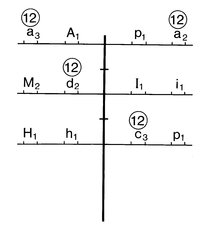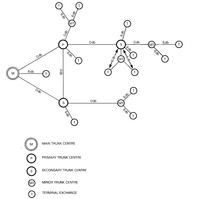


Chapter 8
I Part 1: Communications
i Before the Telegraph
ii Electrical Communication Before Federation
iii Federation to the End of the Second World War
iv Post-war and on to 1975
v 1975 ONWARDS
II Epilogue
III Part 2: Early Australian Computers And Computing
IV Acknowledgements
References
Index
Search
Help
Contact us

Post-war and on to 1975 (continued)
In the immediate post-war years new trunk network plans were produced with more ambitious objectives, including fully automatic transit switching and the possibility of a limited amount of subscriber trunk dialling using multi-metering for charging. A multi-metering committee formed in the early 1950s, defined the facilities required and identified the need for simplifying the charging system. As, for short routes in particular, multi-metering was found to be more economical than manual switching, equipment designs were produced and used on a number of short distance routes around Melbourne and Sydney, using arbitrary access codes.As another basis for planning and developing the network, the APO specified telephone network transmission performance standards with separate requirements for each of the subscribers' services, the junction and the trunk network. In the case of the junction network an individual transmission design, using a mixture of loaded and unloaded cable of varying conductor weights, or in some cases carrier circuits, was required for each city as follows:
- The total attenuation between any two exchanges not to exceed 15 db, including the loss of all intermediate exchanges on a through connection, but not the loss in the terminal exchange which was part of the subscribers' service standard.
- The total attenuation from any exchange within the junction network to the trunk exchange not to exceed 7.5 db.
The transmission design for the trunk network is illustrated in Fig. (17) and was based on:
- trunks between main trunk centres to be zero loss equivalents;
- the total loss from any trunk exchanges to its main trunk centre not to exceed 7.5 db.

While transmission performance standards were being developed, a planning basis was established for a rapid increase in main line trunk circuits. In the longer term, developments in radio were seen as holding promise but it was clear that for many years carrier circuits on open wire routes would be a major method of trunk channel provision, with carrier cables between certain large provincial cities and their capital city also playing a role, while tentative plans were developed for the first coaxial cable systems, but these did not mature for more than a decade.
Thus the APO looked to the full exploitation of the channel carrying capacity of existing open wire routes, together with the construction of new high grade routes. It was decided also that rather than develop transposition schemes for individual routes, a series of standard transposition designs would be produced. To meet the electrical requirements, consideration had to be given to:
- Use of suitable transposition types
- Control of third circuit effects
- Reduction of coupling between pairs
- Uniform construction to allowable tolerances
- Impedance matching to specified limits between different types of construction
- Layout of transposition sections
- Use of suitable junction transposition schemes

Organisations in Australian Science at Work - Australian Post Office (A.P.O.)
 |
Australian Academy of Technological Sciences and Engineering |  |
© 1988 Print Edition pages 563 - 564, Online Edition 2000
Published by Australian Science and Technology Heritage Centre, using the Web Academic Resource Publisher
http://www.austehc.unimelb.edu.au/tia/548.html